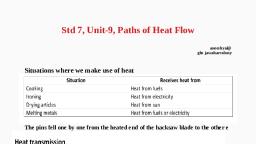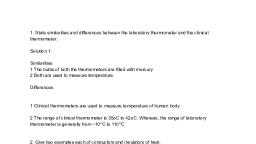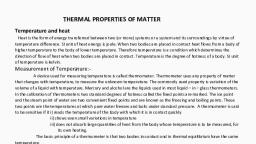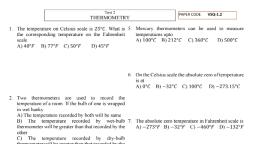Page 1 :
Introduction, , You shiver, when it is cold, outside and, sweat when it, is hot outside,, but how can, you measure those weather temperatures?, Temperature is involved in many aspects of our, daily lives, including our own bodies and health;, , the er; and how hot the stove must be in, , , , , , , , , , , , , , , , , , , , , , , , , er to cook food., , he measurement of warmness or, ess of, , , , , , , substance is known as its temperature., , is a measure of the average kinetic en, , of the particles in an object. Tempera’, , , , Temperature Units:, ere are three units, , : FahWjpheit is written as °F for, nple 25°F; i, Fahrenheit,, , read as twenty five degree, , Kelvin: Kelvin is written as K. For example, 100K; it is read as hundred Kelvin., , “* The SI unit of temperature is kelvin (K),, , , , , , 1.3 Measuring Temperature, , ‘The temperature of the, object is well approximated, with the kinetic energy of, the substances. The high, temperature means that the, , , , , , , , , , , , molecules within the object, are moving at a faster rate., , But the question arises, how to measure, it? Molecules in any substance are very small, to analyze and calculate its movement (Kinetic, energy) in order to measure its temperature., You must use an indirect method to measure the, kinetic energy of the molecules of a substance., , We studied that solids expands when heatis, supplied to it. Like solid substances, liquids are, also affected by heat. To know this let us do the, activity 1., , In a thermometer, when liquid gets heat,, it expands and when it is cooled down, it, , contracts. It is used to measure temperature., , Like solid and liquid objects, the effect of, heat is also observed on gaseous objects., , 1.4 Thermometer:, ‘Thermometer is the most common instrument, to measure temperature., , There are various kinds of thermometers., of them are like glass tubes which look, thin and are filled with some kind of liquid., Why Mercury or Alcohol is used in, Thermometer?, stly Alcohol and Mercury are used in, thermometers as they remain in liquid form, , even with a change of tempera! them., , , , , , , A small change in the temperature, change in volume of a liquid. We measure, temperature by measuring expansion of a li, in thermometer.
Page 2 :
SE, , What is required?, , A small glass bottle, a rubber cork, an empty refill, water, colour,, a candle, a fork, a paper., , What to do?, , + Take a small glass bottle, Fill it with coloured water., , Make hole at the centre of the rubber cork., , « Pass empty refill from the hole of the rubber cork., , « Make the bottle air tight and observe the water raised in the refill, , Make a scale on paper, place it behind the refill and note down the, , position of the surface of water., , + Hold bottle with fork and supply heat to it with candle. Then observe. tev, , What is the change in the surface of water?, , , , ¢ Stop the supply of heat. When water is cooled, observe the surface, of water in the refill, what change takes place? Why?, , , , , , , , , it contracts., , roperties of Mercury:Its expansion is uniform. (For equal amounts, , , , , , of heat it expands by equal lengths.), is opaque and shining. Stab, ett not stick to the sides of the glass tube. types of thermometers for, * Itisa good conductor of heat. measuring the temperatures :, , of different things like air, co], , an, our bodies, food and many | V4A419, other things. Among these,, , + Ithasa high boiling point (357°C) and alow, freezing point (-39°C). Hence a wide range, , , , , , , , , , , , , of temperatures can be measured using a, the commonly used thermometers are clinical, , mercury thermamet, thermometers and laboratory thermometers., Properties of Alcohol, The freezing point of alcohol is less than 1.4.1 Clinical Thermometer, , 100°C. So it can be used to measure very ‘These thermometers are used to measure, peratures. the temperature of a human body, at home,, clinics and hospitals, All clinical thermometers, , «Its expansion degree Celsius rise in, 1 ee have a kink that prevents the mercury from, , temperature is very large.
Page 3 :
there is no kink in the lab thermometer., , A laboratory thermometer has only the, Cee, , Celsius scale ranging from -10°C to i Measure your body temperature, , 110°C, ie Wash the thermometer preferably with an, antiseptic solution. Hold it firmly by the end, , and give it a few jerks. These jerks will bring, , the level of Mercury down. Ensure that, , it falls below 35°C (95°F). Now place the, , thermometer under your tongue or arm pit., , Precautions to be Followed While, Using a Laboratory Thermometer, , i, , « Do not tilt the thermometer while, measuring the temperature. Place it, , meget seine, , , , upright. \ After one minute, take the thermometer out, * Note the reading only when the and note the reading. It tells you your body., bulb has been surrounded by the SesUpETELOres Pees did you record as your, substance from all sides. ‘ body tenrperataret, | > In humans, the average activity 4 |, internal temperature is ’, ~~ awe 37°C (986°F), though it Use of Laboratory thermometer, mr varies among individuals. © Take some water in a beaker., However, no person always has exactly . parc a laboratory thermometer and, the same temperature at every moment of. Bmmneese, Hs bulb end in waters holding, the day. T tareaiercie ce it vertically. Ensure to dip whole portion, : 8 of bulb end. The bulb end should not, | and ‘down ‘through the day according to touch the bottom or side of the beaker., | activities and external factors., , « Observe the movement of rise of, mercury. When it becomes stable, take, the reading of the thermometer., , ¢ Repeat this with hot water and take the, reading., , , , , , , , , , , , Difference between clinical and laboratory thermometer, , Clinical Thermometer Laboratory Thermometer, , (Clinical thermometer is scaled from 35°C to 42°C Laboratory thermometer is generally scaled from, ’ im 94°F to 108°F, 10°C to 110°C., , Peeer Tevel d6es not fall on its Own, as there is, , kink near the bulb to prevent the fall of mercury Mercury level falls on its own as no kink is present., , level., erento ete, ie ‘Temperature is read while keeping the thermomet, hermometer from armpit or mouth., , , , in the source of temperature, ¢.g. a liquid or any, Z pinay ; other thing., , [To lower the mercury level jerks are given! | No need to give jerk to lower the mercury level., [It'is ised for taking the body temperatures”) It is used to take temperature in laboratory., , 5
Page 4 :
ST SSCs, , What is required?, , , , A big bottle, a balloon, threads, candle, water, fork, , What to do?, , + Take one big bottle, and fill some water in it., , « Attach one balloon on the mouth of bottle and fix it with thread., ¢ Hold bottle with a fork. Heat the bottle with a candle and take, , observation., , « What change occurs in the state of balloon after heating the bottle?, , , , Why?, Now, let the bottle get cooled down., , « What change occurs in the state of balloon after heating the bottle?, , , , , , What change occurs in the state of balloon after bottle gets cool down?, , Why? —, When gases substance gets heat, it expands; when it cools it contracts., Why does a tyre get burst in summer? ---------------------------------, flowing back into the bulb when the, thermometer is taken out of the patient's, mouth, so that the temperature can be, noted conveniently. There are temperature, scales on either side of the mercury, thread, one in Celsius scale and the other, in Fahrenheit scale. Since the Fahrenheit, scale is more sensitive than the Celsius, scale, body temperature is measured in, F only. A clinical thermometer indicates, , , , temperatures from a minimum of 35°C or, 94°F to a maximum of 42°C or 108°F., , Precautions to be Followed While Using a, Clinical Thermometer, , + The thermometer should be washed before, and after use, preferably with an antiseptic, , solution., , « Jerk the thermometer a few times to bring, the level of the mercury down,, , ‘ie, , ¢ Before use, the mercury level should be, below 35°C or 94°F., , ¢ Do not hold the thermometer by its bulb., , « Keep the mercury level along your line of, sight and then take the reading., , « Handle the thermometer with care. If it hits, against some hard object, it may break., , « Donot place the thermometer in a hot flame, or in the hot sun., , 1.4.2 Laboratory Thermometers, Laboratory thermometers are used to, measure the temperature in school and other, laboratories for scientific research. They are, also used in the industry as they can measure, temperatures higher than what clinical, thermometers can record. The stem and the, bulb of a lab thermometer are longer when, compared to that of a clinical thermometer and












































